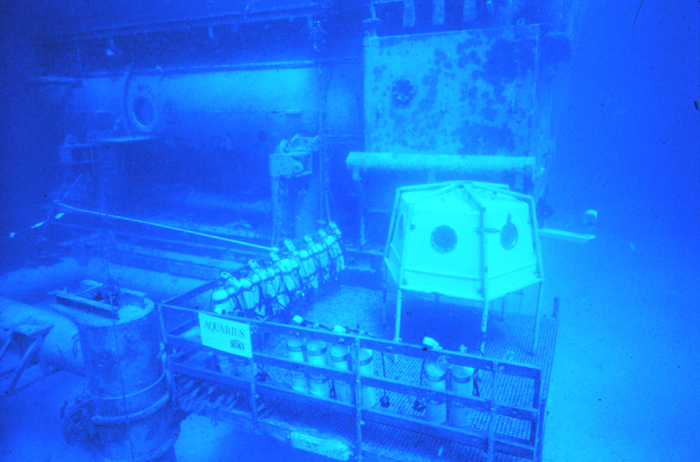NOAA Miami Regional Library at AOML
A Branch of the NOAA Central Library
 |
 |
Aquarius Reef Base
A Bibliography of Scholarly Research
The Aquarius Reef Base is an undersea research laboratory facility within the Florida Keys National Marine Sanctuary located in Key Largo, Florida. The focus of its mission includes science research, coral reef and ocean observing, undersea technology development, national training facility and ocean education outreach. This facility allows scientists to participate in one to two week missions conducting research, surveys and test equipment underwater. The undersea habitat is owned by the National Oceanic and Atmospheric Administration (NOAA). The program is operated out of Key Largo, Florida by University of North Carolina Wilmington (UNCW). This bibliography is based on the work conducted in 2008 at Aquarius Reef Base. For information regarding continuous research 2009 contact Dr. Ellen Prager, Chief Scientist, Aquarius Reef Base.
Please note that full-text links to the publisher's version of the included articles are only provided for those who have licensed access to these materials. Those who do not have access to the full-text documents and wish to use them for scholarly or research purposes should contact NOAA Miami Regional Library.
2008 Publications
(2008). Redwoods of the Reef. Science 321(5885)19. FULL TEXT ( Available to some NOAA users.)
Auster, P.J. & J. Lindholm. (2008). Variation in social foraging by fishes across a coral reef landscape. Proceedings of the 11th International Coral Reef Symposium, Ft. Lauderdale, Florida 7-11 July 2008. Available via interlibrary loan. NOAA Miami Regional Library.
Bromage, E. & Carpenter, L. (2008). Quantification of coral heat shock proteins from individual coral polyps.
Marine Ecology Progress Series, 376,123-132. Available via interlibrary loan NOAA Miami Regional Library.
Burkepile, D. E. & Hay, M.E. (2008). Herbivore species and richness and feeding complementarity affect community
structure and function on a coral reef. PNAS, 105(42) 16201-16206. Available via interlibrary loan. NOAA Miami Regional Library.
(2008). Diversity of Plant-eating fishes may be key to recovery of Coral Reefs. eScienceNews FULL TEXT.
Fletcher, J., Haus, B.K. et al. (2008). Physical processes impacting passive partical dispersal in the Upper Florida Keys.
Continental Shelf Research. 28, 1261-1272. FULL TEXT (Available to some NOAA users.)
Leichter,J.J., Stokes, M.D. et. al. (2008). Deep water macroalgal communities adjacent to the Florida Keys reef tract.
Marine Ecology Progress Series, 356, 123-138. Available via interlibrary loan. NOAA Miami Regional Library.
Lopez-legentil, S., Song, B. et. al. (2008). Bleaching and stress in coral reef ecosystems:
hsp 70 expression by the giant barrel sponge Xestospongia muta. Molecular Ecology, 155(17)159-171 FULL TEXT (Available to some NOAA users.)
McMurray, S. E., Blum, J.E., & J.R. Pawlik. (2008). Redwood of the reef: growth and age of the giant barrel sponge
Xestospongia muta in the Florida Keys. Marine Biology, 155, 159-171. FULL TEXT (Available to some NOAA users.)McMurray, S.E. & Pawlik, J.R.(2008). A novel technique for the reattachment of large coral reef sponges.
Restoration Ecology 17,(2) 192-195. Available via interlibrary loan. NOAA Miami Regional Library.Miller, M. (2008). Aquarius Coral Restoration/Resilience Experiment. (ACCRE). FULL TEXT.
Mohamed, N.M., Coleman, A.S. et. al. (2008). Diversity and expression of nitrogen fixation genes in bacterial symbionts of marine sponges.
Environmental Microbiology, 10(11) 2910-2921. Available via interlibrary loan .NOAA Miami Regional Library.
Mohamed, N.M., Enticknap, J.J. et al. (2008). Changes in bacterial communities of the marine sponge mycalse laxissima on transfer into aquaculture.
Applied and Environmental Microbiology, 74(4) 1209-1222. Available via interlibrary loan. NOAA Miami Regional Library.
Mohamed, N.M., Mark, V.R. et al. (2008). Monitoring bacterial diversity of the marine sponge ircinia strobilina upon transfer into aquaculture.
Applied and Environmental Microbiology. 74(13) 4133-4143. Available via interlibrary loan . NOAA Miami Regional Library.
(2008). NOAA supports sound science and effective management for the conservation and sustainability of deep-sea coral and sponge ecosystems.
NOAA Deep Sea Coral Program FULL TEXT.Schrope,M. (2008). Sleeping with the fishes. Nature Reports Climate Change.159-160. FULL TEXT.
Schrope,M. (2009). The lab at the bottom of the sea. Nature, 457, 141-143. Available via interlibrary loan. NOAA Miami Regional Library.
Southwell, M.W., Popp, B.W. et al. (2008). Nitrification controls on fluxes and isotopic composition of nitrate from Florida Keys sponges.
Marine Chemistry,10, 896-108. FULL TEXT (Available to some NOAA users.)
Valentine, J.F., Kenneth, J. Heck, I. et. al. (2008). Exploited species impacts on trophic linkages along reef-seagrass interfaces in the Florida Keys.
Ecological Appliations, 18 (6) 1501-1515. Available via interlibrary loan. NOAA Miami Regional Library.
Weisz, J.B., Lindquist, N. & Martens, C. (2008). Do associated microbial abundances impact marine demosponge pumping rates and tissue densities?
Oceologia, 155, 367-376. Available via interlibrary loan .NOAA Miami Regional Library.
Questions? Comments? Suggestions? Please contact the library.

Photos courtesy
of NOAA Photo Library
Web work created and compiled by Christie
Wiley, Librarian
For additional research and contributions email
Linda Pikula, Regional Librarian,
NOAA Miami Regional Library
